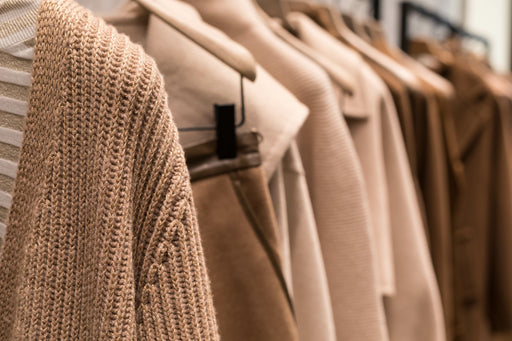Camel Hair Fabrics

Have you seen some of your favourite designers offering camel hair sweaters, suits, scarves, and coats? Are you wondering what’s so special about these fabrics and how camel hair is different from cashmere and other types of wool? If so, then you’re definitely in the right place!
Today, we’re going to share more information about just what camel hair is, how camel hair is made, and some of the most common uses for camel hair. We’ll also address how it’s similar to and different from wool. So, keep reading to discover whether you’ll want to add this to your wardrobe.
What is camel hair?
Camel hair, also known as camel wool or camel cashmere, is a fabric made using hairs from the Bactrian camel. Bactrian camels are found primarily in Asia between Turkey, China, and Siberia, with the greatest populations in the Mongol Steppes region. While many camels have short hair, Bactrian camels have much longer hair that can be made into fabrics.
The first uses of camel hair date back to the ancient cultures of individuals living in the Mongol Steppes. Towards the end of the British Empire, it was a popular choice for textiles, and recently camel wool has become increasingly popular for garments since it is cruelty-free and more sustainable than other fabric types.
Bactrian camels have both an undercoat and outer guard hair. The guard hair is designed to offer protection and warmth to a camel against very old winters. This hair is thick and hard and can make camels appear fuzzier in the middle of the winter. The coarse and hard texture of the guard hair does not make it very desirable for making fabric, though it may sometimes be mixed with other materials such as sheep’s wool to make some thicker fabrics.

Conversely, a Bactrian camel’s undercoat is extremely soft. The job of the undercoat is to insulate the camel and keep them warm. This soft undercoat is what most camel hair fabrics, particularly garments, are made from.
There are three grades of camel hair fabric: high, medium and low. The fineness of the hair as well as its colour determine whether fibres are categorised as high-, medium-, or low-grade. High-grade camel wool, which comes from the undercoat, is characterised by its very fine and soft texture. High-grade fabrics are light tan in colour.
Most camel hair fabrics used to make apparel are high-grade, though some medium-grade fibres may also be used. Medium-grade fibres also come from the undercoat, but they are longer and have a coarser texture than high-grade fibres. Garments made using medium-grade fibres will feel rougher than those made using high-grade fibres.
Low-grade fibres come from the camel’s guard hair. Since these hairs are much thicker and coarser, they are not suitable for use in making garments. They can be used for other applications such as making carpets and other textiles.
How is Camel Wool Made?
Unlike other animals that must be sheared to get their wool, Bactrian camels naturally shed their hair in the late spring or early summer. This means that camel hair is more sustainably sourced and there is less concern about mistreatment of animals during the harvesting process, as there is with other types of wood. Camels don’t need to be restrained, facing the possibility of injury, to have their wool harvested. Breeders can just wait until all the camels’ hair has fallen off. However, some breeders do still shear their camels if the hair hasn’t all fallen off, but they do not shear the area covering the camel’s humps that help protect them against diseases.

After the hair has fallen off the camel, it must be washed to remove dirt and other impurities. The hair is then separated into individual strands, a process referred to as carding. Once carded, the camel wool can be spun into yarn. The yarn is washed one last time, then it is ready to be used to make garments and other textiles.
Where is Camel Hair Made
Mongolia is the largest exporter of camel hair in the world. Many Bactrian camel breeders in Mongolia are nomadic and are descendants from a long line of Bactrian camel breeders. Many of these breeders follow the age-old techniques of harvesting the camel wool that their ancestors from long ago followed, however some breeders have adopted more modern methods to harvest the hair from a camel.
Some other countries that also produce and export camel hair include Russia, China, Tibet, Iran, and Afghanistan. These five countries are also located in Asia, not far from Mongolia. Some of the same nomadic tribes from Mongolia and the Mongol Steppes are also found in these other countries.
Australia, New Zealand, the United States, and South Africa also produce smaller quantities of camel hair fibre.
Uses for Camel Hair
Camel hair is an excellent insulator. Its thermostatic properties work to keep camels warm during frigid and snowy winters in the mountains, while also helping them stay cool in the hot desert sun. Fabrics made from camel hair share these same properties, making it a versatile fabric with a wide range of uses. In fact, it is such a versatile and valuable material that as far back as the Bible you will find mention of camel hair fabric being used to make tents, cloaks, and carpets.

Some of the more common uses for camel hair include scarves, sweaters, suits, coats, and even undergarments. The coarser camel guard hairs are often used for thicker textiles such as carpets or tents.
Camel Wool Care and Cleaning
Camel hair should be hand washed to protect the fabric and extend its usable life. Always check the garment’s care label first, since some camel hair items, particularly suits, may be labelled as dry-clean only.
If your camel wool item is not labelled as dry-clean only, you can wash it in a wash basin using cold water. Camel hair is a very sensitive material, and may be prone to shrinkage or damage if not treated with care. Add a detergent designed for wool and other natural fibres to the cold water in the wash basin and gently mix to stir it into the water.
Add your camel hair item to the basin, submerge it, and agitate it gently. Then, allow the item to sit in the soapy water for up to 30 minutes. After 30 minutes have passed, remove the garment, drain the water from the wash basin, wash away any excess soap in the basin, and place the camel wool garment back in the basin. Rinse it with cold water and repeat, draining the basin and rinsing again until all the soap has been removed and the water runs clear.
After you have completely rinsed out the garment, gently press the water out from it. Take care not to wring it out, as doing so may damage the item or cause it to stretch out. Dry camel wool items laying flat away from direct heat or sunlight.
Once dry, carefully store camel hair to protect it from moths. Sweaters, scarves, and other foldable items will do best stored in a drawer with cedar chips or moth traps. For coats, suits, and other more structured items, use moth-proof hanging garment bags and hanging moth traps to preserve and protect your items.

Camel Hair vs Wool
When many people hear wool, they think of fabric made from the fleece of sheep, but wool fabric actually refers to any fabric made from the hair of an animal. So, technically speaking, camel hair is one type of wool. However, since every animal’s hair is different, each wool fabric yielded from an animal is also different.
Comparing camel hair to popular types of wool can help you more clearly understand the key differences. A common comparison is camel hair vs Cashmere. Cashmere is a special type of wool made using the hair of Cashmere goats.
Both Cashmere and camel hair are incredibly soft and warm. Cashmere garments are very lightweight and have a high moisture content. This allows them to offer varying levels of insulate based on the climate and humidity. Camel wool has thermostatic properties to keep camels cooler in hot deserts and warmer in the cold and snowy mountains. Garments made from camel hair share these same characteristics.
One key difference between camel hair and cashmere lies in production. While Cashmere goats must be sheared for their hair, camel’s naturally shed their hair in the spring and summer.
This makes camel wool more sustainable and removes some of the more questionable, or even cruel, aspects of harvesting wool from other animals.
Camel Hair Fabrics Explained
Camel hair is a plush and soft fabric that is sustainably sourced. It offers a variety of applications from underwear, sweaters, coats, carpets, and even tents. Are you ready to add some camel hair to your wardrobe?

About MothPrevention
MothPrevention® speak to customers every day about their clothes moth issues - clothes moths are a species that are ever increasing and that can cause significant damage to clothes, carpets and other home textiles.
To date, we’ve helped over 250,000 customers deal with their moth problems. We have developed professional grade solutions including proprietary pheromones and trap design engineered to the highest production standards.





